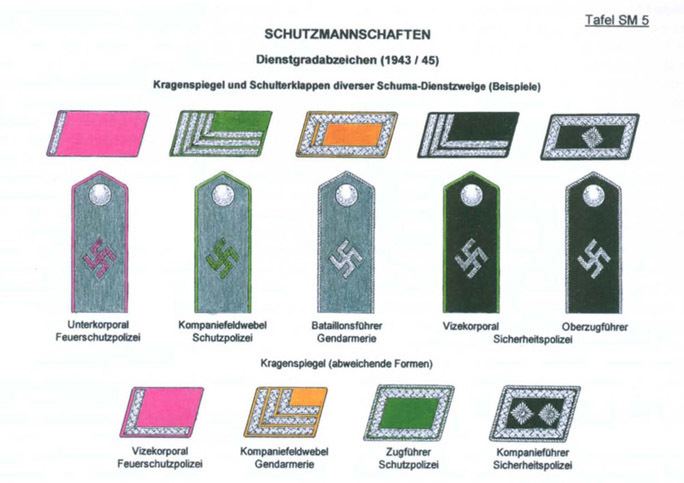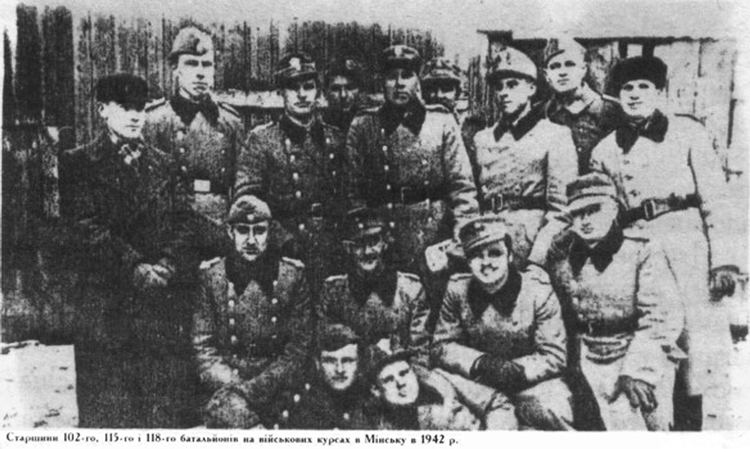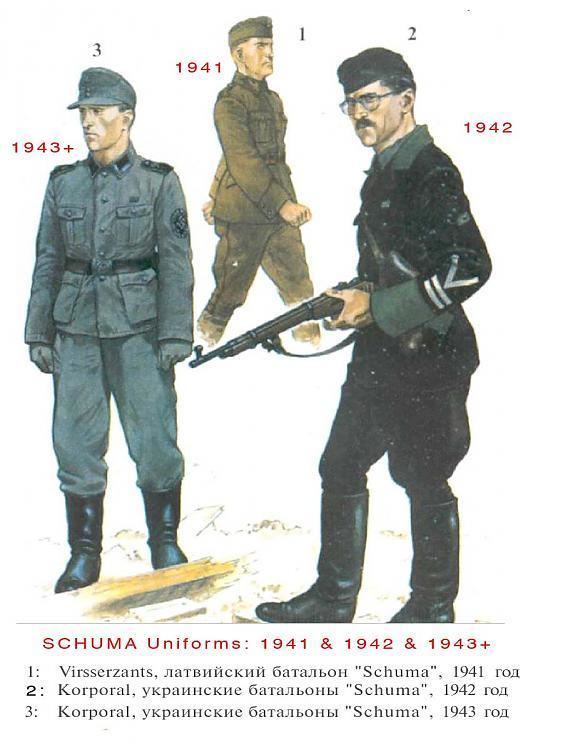Type Auxiliary police Allegiance Ordnungspolizei | Size 300,000 | |
 | ||
Active Founded in July 1941 by Heinrich Himmler Country German-occupied Eastern Europe Similar Ordnungspolizei, Byelorussian Home Defence, Estonian Legion | ||
The Schutzmannschaft or Auxiliary Police (literally: "protection team"; plural: Schutzmannschaften, abbreviated as Schuma) was the collaborationist auxiliary police of native policemen serving in those areas of Eastern Europe occupied by Nazi Germany during World War II. Reichsführer-SS Heinrich Himmler established the Schutzmannschaft on July 25, 1941 and subordinated it to the Order Police (Ordnungspolizei; Orpo). By the end of 1941, some 45,000 men served in Schutzmannschaft units, about half of them in the battalions. During 1942, Schutzmannschaften expanded to an estimated 300,000 men, with battalions accounting for about a third of the force. Everywhere, local police far outnumbered the equivalent German personnel several times (in most places, the ratio of Germans to natives was about 1-to-10).
Contents

The Schutzmannschaften have a reputation for their Police Battalions (Schutzmannschaft-Bataillonen). Created to support German war efforts, in particular combating anti-Nazi partisans, many of these battalions participated in the Holocaust and caused thousands of Jewish deaths. Usually the battalions were voluntary units and were not directly involved in combat. In total, about 200 battalions were formed. Each battalion had an authorized strength of about 500, but the actual size varied greatly. They should not be confused with native German police battalions (SS-Polizei-Bataillone) which the Order Police formed between 1939 and 1945 and which also participated in the Holocaust (see Ordnungspolizei Police Battalions and Reserve Police Battalion 101).
The Order Police organized the Schutzmannschaften by nationality (see Lithuanian Auxiliary Police, Latvian Auxiliary Police, Estonian Auxiliary Police, Belarusian Auxiliary Police, and Ukrainian Auxiliary Police).

Formation

The Germans did not want to use local collaborators on a large scale as they were deemed to be unreliable and inferior (Untermensch). However, rapid German advance in the Eastern Front and manpower shortages forced Germans to reconsider. Therefore, on July 25, 1941, Reichsführer-SS Himmler authorized creation of Schutzmannschaft. Initially, it was called Hilfspolizei, but Germans did not want to attach reputable police title to this force. Schutzmannschaften was an integral part of German police structure and dealt with variety of issues, including everyday crimes (except when concerning German citizens). Initially, only a small fraction of local auxiliaries were armed. Due to limited supervision, particularly in rural areas, members of Schutzmannschaften had considerable power and there were frequent complaints of corruption and abuse.
Initially, Schutzmannschaften was organized based on existing structures and spontaneous anti-Soviet groups that formed at the start of the German invasion of the Soviet Union. For example, in Lithuania, Schutzmannschaften absorbed units formed by the Provisional Government. Due to this legacy and its semi-military status, Lithuanians associated police battalions with their national aspirations of independent Lithuania. This caused a rift within German ranks: ideologues like Hitler and Himmler saw no place for Baltic nationalism within the Greater Germanic Reich, but Nazis needed local collaboration and had to maintain at least a shadow of national institutions.
Local men joined Schutzmannschaften due to a variety of reasons. A number of them had police or military experience and wanted a job which paid steady wages and provided food rations. Joining German war apparatus also provided certain privileges and protections for the men and their families (for example, exemption from forced labor). Pensions were available to family members of those killed in anti-partisan operations. Others were motivated by ideological reasons (antisemitism, anticommunism, nationalism) or by opportunities to loot property of murdered Jews. Captured Soviet POWs saw Schutzmannschaften as a way to avoid concentration camps. Such considerations attracted criminals and other opportunists. Most of them were young: in 1944, about half of Schutzmannschaften near Mir were under 25 years of age. Germans complained about their lack of training, discipline, and in some cases refused to supply them with weapons. During 1942, in compliance with orders to enlarge Schutzmannschaft, Germans began to force men to sign up for the service and eliminated service term limits (initially men signed up for one-year or six-month terms). There was a marked difference in attitudes of more enthusiastic early volunteers and later forced recruits. To increase their reliability, Himmler ordered to organize NCO training, which would include political education, that lasted up to eight weeks.
Organization
Schutzmannschaft was divided into four sections:
Police battalions
Police battalions were divided based on their intended functions into five categories:
Each battalion had a projected number of four companies of 124 men each, one with a group of machine gun and three groups of infantry. In reality, the numbers varied greatly between occupied territories. Baltic (Lithuanian, Latvian, Estonian) battalions were commanded by a native, while Ukrainian and Belarusian battalions had German commanders. The battalions did not have a prescribed uniform and often used uniforms from pre-war national armies. They were identified by a white armband which usually had the inscription Schutzmann, a service number and location. Hitler expressly prohibited Schutzmannschaft to use German badges of rank, the eagle and swastika emblem, or German military shoulder straps. Schutzmannschaften were generally armed with confiscated Soviet rifles and some officers had pistols. Machine guns were used in anti-partisan operations and mortars were employed in the later stages of the war. In general, the battalions were poorly provided for, sometimes even lacking food rations, as priority and preference was given to German units fighting in the front lines.
The Schutzmannschaft battalions were organized by nationality: Ukrainians, Belarusians, Estonians, Lithuanians, Latvians, Tatars. Germans attempted to organize police battalions in occupied Poland, but did not find volunteers and had to use force in forming the single Polish Schutzmannschaft Battalion 202. The battalions were initially allotted numbers as follows (in brackets: re-allotted numbers in 1942; not all numbers were actually used):
The battalions were not confined to their locations and could be easily moved to locations far outside their home country. Since formation of the battalions was particularly slow in Belarus, many of them were first stationed there. One of the first tasks of the battalions was mass execution of Jews. Attached to Einsatzgruppen as needed, the battalions rounded up, executed, and disposed of Jews. For example, it is estimated that Lithuanian Schutzmannschaft killed 78,000 Jews in Lithuania and Belarus. The mass executions largely ceased by the end of 1941. By that time German advance into Soviet Union halted and Nazi officials considered using the battalions for more direct military duties. In particular, Franz Walter Stahlecker asked to relieve the 16th Army in the Demyansk Pocket. However, Hitler refused. In Directive no. 46, dated August 1942, he agreed to strengthen and enlarge Schutzmannschaft, but to use it only for anti-partisan operations and other auxiliary duties behind the front lines. Some battalions continued to participate in the Holocaust (guarding or eliminating Jewish ghettos). The issue of involving Schutzmannschaft in combat was revisited after the Battle of Stalingrad. Some Schutzmannschaft battalions in Estonia, Latvia, Ukraine and elsewhere were reorganized into Waffen-SS divisions wearing national insignia. Deserters were a constant problem for the battalions. For example, some 3,000 men deserted Lithuanian Schutzmannschaft between September 1943 and April 1944.
